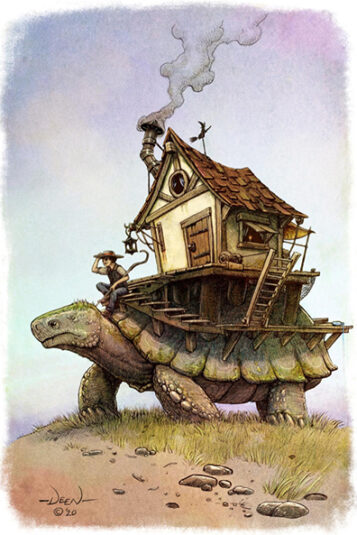 Today we’re featuring David Deen, the amazing illustrator of Tolo, Cotsen’s digital adventure! Furiously sketching and coloring owlbears and nagas from his brother’s D&D books, David also grew up reading fantasy books. After earning a BA in Art, David worked as a computer game artist before going freelance. We asked him to give us a quick tour of his Colorado studio (and we get to meet his cats)!
Today we’re featuring David Deen, the amazing illustrator of Tolo, Cotsen’s digital adventure! Furiously sketching and coloring owlbears and nagas from his brother’s D&D books, David also grew up reading fantasy books. After earning a BA in Art, David worked as a computer game artist before going freelance. We asked him to give us a quick tour of his Colorado studio (and we get to meet his cats)!
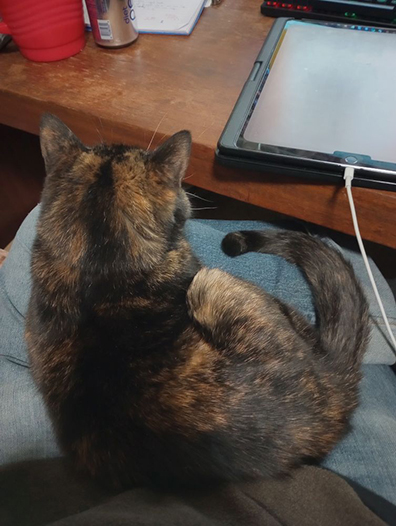
As my art has shifted to being mostly digital, my studio space has shrunk to a fairly compact little space in the corner of my basement. I still have a sketchbook for initial concept sketching and printouts of the information I need to reference. And we have two cats that keep me company as I work, Summer (shown above) and Smudge.
Most of the work is done on my iPad Pro, where I use a couple of different programs designed to provide the look of traditional media with the benefits of easy revisions and no loss of quality from the artwork being photographed or scanned.
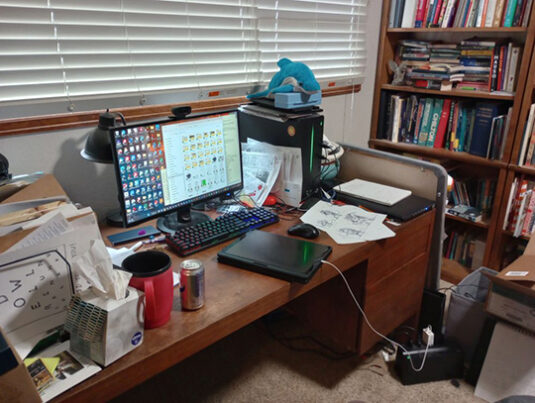 While I’m working on the illustrations, I use the computer to find reference photos and look up information I might need… and to entertain my ears with music. Once the final images are created, I send them straight to the computer through Dropbox. Then I can finalize the files, send them to the client, and do all of the other business involved in illustration.
While I’m working on the illustrations, I use the computer to find reference photos and look up information I might need… and to entertain my ears with music. Once the final images are created, I send them straight to the computer through Dropbox. Then I can finalize the files, send them to the client, and do all of the other business involved in illustration.
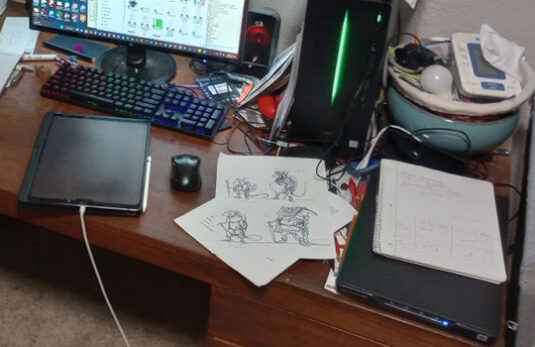 The studio for creating traditional artwork is currently being used as a guest bedroom; the drafting table is folded down and the supplies are all put away. I hope to get back in there in the new year and make some paintings again, but in the meantime, my little digital corner of the basement is enough to keep me making all the artwork I need.
The studio for creating traditional artwork is currently being used as a guest bedroom; the drafting table is folded down and the supplies are all put away. I hope to get back in there in the new year and make some paintings again, but in the meantime, my little digital corner of the basement is enough to keep me making all the artwork I need.
Images courtesy of David Deen

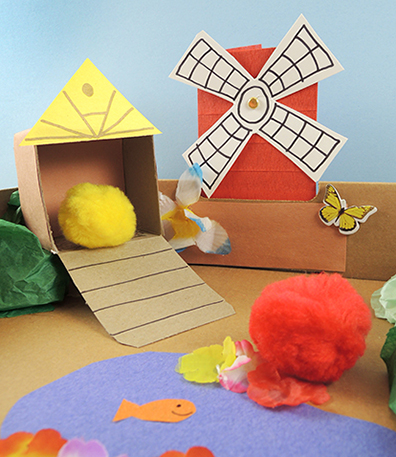 It’s a merry chase! Use your motor skills to navigate a yellow pom-pom hen around the barnyard. But beware the red pom-pom fox, who’s also on a roll!
It’s a merry chase! Use your motor skills to navigate a yellow pom-pom hen around the barnyard. But beware the red pom-pom fox, who’s also on a roll!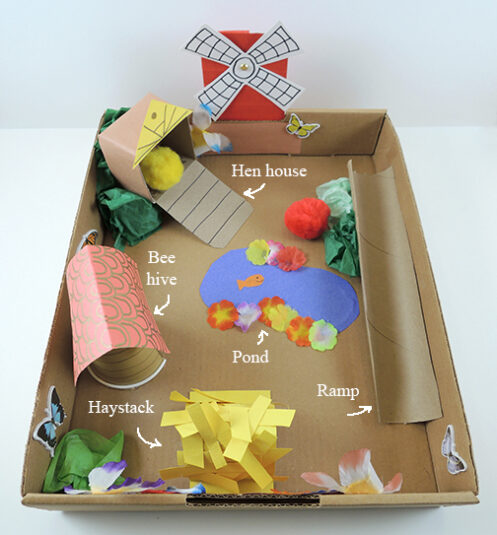 As you can see in the above photo, we used a copy paper box lid as the base of our barnyard. Then we glued a number of elements in place. The bee hive was a paper cup with an arched door. The haystack was a construction paper tunnel. The ramp was a paper towel tube, cut in half length-wise and elevated with a snippet of the remaining tube. The hen house was a small box with the lid positioned as a ramp, also elevated with a snippet of paper towel tube. We added a pond, fabric flowers, and tissue paper shrubs as well.
As you can see in the above photo, we used a copy paper box lid as the base of our barnyard. Then we glued a number of elements in place. The bee hive was a paper cup with an arched door. The haystack was a construction paper tunnel. The ramp was a paper towel tube, cut in half length-wise and elevated with a snippet of the remaining tube. The hen house was a small box with the lid positioned as a ramp, also elevated with a snippet of paper towel tube. We added a pond, fabric flowers, and tissue paper shrubs as well.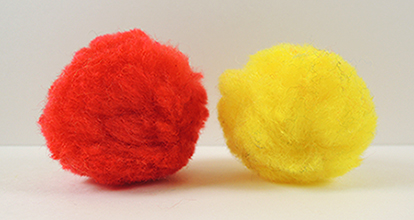
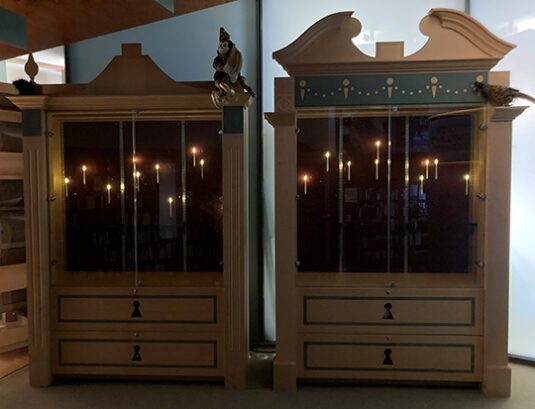
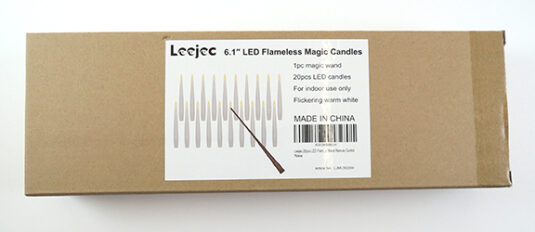 Each candle requires a AAA battery (not included) and had a long, invisible fishing line extending from the top. But the best part is…wait for it…you turn them on and off with a wand!
Each candle requires a AAA battery (not included) and had a long, invisible fishing line extending from the top. But the best part is…wait for it…you turn them on and off with a wand!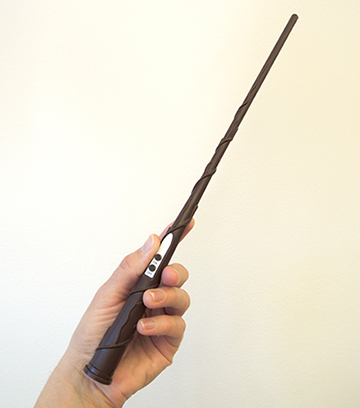 Hanging the candles was a bit tricky. The fishing lines are really, really, really long. We ended up wrapping them around paperclips (which was kind of slippery and frustrating until you got the hang of it), securing them with tape, sticking the wrapped paperclip through some plastic light covers in the case, and then anchoring the wrapped paper clips with more tape. It definitely took some time and patience!
Hanging the candles was a bit tricky. The fishing lines are really, really, really long. We ended up wrapping them around paperclips (which was kind of slippery and frustrating until you got the hang of it), securing them with tape, sticking the wrapped paperclip through some plastic light covers in the case, and then anchoring the wrapped paper clips with more tape. It definitely took some time and patience!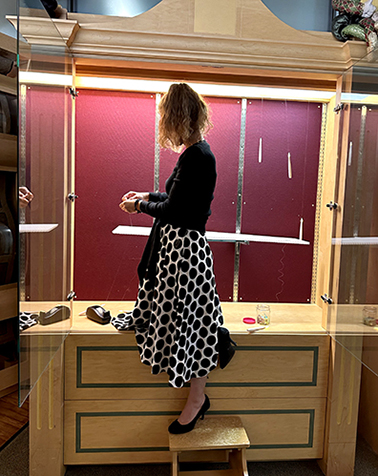 In the reviews on Amazon, some folks used thumbtacks to secure the candles to the ceiling, some used poster putty. Others hung them on already existing light fixtures. It was agreed the fishing lines were super long, but for people with cathedral ceilings, that was a bonus.
In the reviews on Amazon, some folks used thumbtacks to secure the candles to the ceiling, some used poster putty. Others hung them on already existing light fixtures. It was agreed the fishing lines were super long, but for people with cathedral ceilings, that was a bonus.